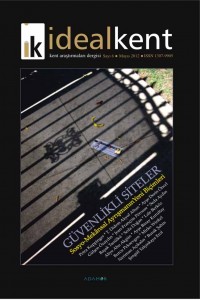Abstract
Bir ucunda mutlak kozmopolitlik, diğer ucunda mutlak
türdeşlik olan bir ayrışma doğrusu hayal edilecek olursa, fiziksel bariyerlerle
çevrili bir güvenlikli site ilk bakışta mutlak türdeşliğin kusursuz bir örneği
olarak kabul edilebilir. Ancak, böyle bir varsayım, fiziksel bir bariyerin
yokluğunda hiçbir içerici/dışlayıcı mekanizmanın devrede olmadığı anlamına
gelmez. Zira görünürde bir bariyerin olmadığı birçok durumda ayrışma, sembolik
bariyerler aracılığıyla gerçekleşmekte ve “mahalle sakinleri” –güvenlikli
sitelerden hiç de aşağı kalmayacak bir biçimde– ayırt edici bir “biz” tahayyülüne
sahip olmaktadırlar. Kısacası fiziksel ve sembolik bariyerler farklı
yöntemlerle de olsa, benzer sonuçlara yol açmaktadırlar. Bu çalışma, söz konusu
süreci anlamak üzere Etiler’deki güvenlikli bir site (Etiler Sitesi) ve
Nişantaşı semt sakinleriyle yapılan derinlemesine görüşmelerin
karşılaştırılması üzerinden, bu iki farklı bariyer tipinin “mahalleli”/biz
kimlik kurgusuna nasıl hizmet ettiğini, “öteki” algısını nasıl
biçimlendirdiğini ve sonuç olarak bütünlüklü bir şehir dokusunu ne şekilde
dönüştürdüğünü incelemeyi amaçlamaktadır.
References
- Anderson, B. (2006). Imagined Communities: Reflections on the Origin and Spread of Nationalism. London: Verso.
- Atkinson, R.& S. Blandy (2006). Gated Communities. London: Routledge.
- Bartu, A. &B. Kolluoğlu (2008). “Emerging spaces of neoliberalism: A gated town and a housing project in İstanbul”, New Perspectives on Turkey, 39, 5-47
- Blakely, E.J..& M.G. Synder (1999). Fortress America: Gated Communities in the United States. Washington D.C.: Brookings Lincoln.
- Bourdieu, P. (2010). Distinction: A Social Critique of the Judgement of Taste. London: Routledge.
- Davis, M. (2007). Planet of Slums, London: Verso.
- Doğuç, S. (2005). “Yeni Orta Sınıfların Gözünden Zenginlik ve Yoksulluk”, Toplum ve Bilim, 104, 73-91.
- Erdoğan, N. (2000).“‘Aşağı’ Sınıflar, ‘Yüksek’ Tahyyüller: Gündelikçi Kadınlar, Emir Erleri ve Benzerlerine Dair”, Birikim Dergisi, 132, 33-38
- Low, S. (2004). Behind The Gates: Life, Security, And The Pursuit of Happiness in Fortress America. London: Routledge.
- Mağgönül, Z. (2005). “Teşvikiye-Nişantaşlıların Serveti”, Toplum ve Bilim, 104, 124-136
- Maher, K.H. (2003). “Workers and Strangers : The Household Service Economy and the Landscape of Suburban Fear”, Urban Affairs Review, 38: 751-786
- Neyzi, L. (2009). “Eski İstanbul'un şehir kültürünü hatırlamak: Yaşanmışlık, Bellek ve Nostalji”, Eski İstanbullular, yeni İstanbullular. İstanbul: Osmanlı Bankası Arşiv ve Araştırma Merkezi, 78-83.
- Öncü, A. (1997). “The myth of the ‘ideal home’ travels across cultural borders to İstanbul”, dans Ayşe Öncü, Petra Weyland (eds.), Space, Culture and Power, Zed Books, pp.56-72
- Pérouse, J.-F.&A.D. Danış (2005). “Zenginliğin Mekanda Yeni Yansımaları: İstanbul’da Güvenlikli Siteler”, Toplum ve Bilim, 104, 92-123
Abstract
If we imagine a line with absolute cosmopolitism at
one pole and absolute homogeneity on the other pole, a gated community
surrounded by physical barriers can be considered as the perfect illustration
of absolute homogeneity. But such a presupposition does not imply that there is
no inclusion/exclusion mechanism when one cannot see any physical barrier. This
is because segregation occurs via symbolic barriers in the absence of visible
boundaries. In such conditions, –like their counterparts living in gated
communities– the inhabitants of non-gated districts also have a distinctive
‘we’ image. In short, while using different methods, both physical and symbolic
barriers entail similar consequences. In order to understand this process,
based on in-depth interviews with Etiler Sitesi and Nişantaşı inhabitants, this
study aims to analyze how symbolic and physical barriers contribute to the
construction of the notion of “we”, how it affects the perception of the
“Other”, and finally how it transforms the unified urban fabric.
References
- Anderson, B. (2006). Imagined Communities: Reflections on the Origin and Spread of Nationalism. London: Verso.
- Atkinson, R.& S. Blandy (2006). Gated Communities. London: Routledge.
- Bartu, A. &B. Kolluoğlu (2008). “Emerging spaces of neoliberalism: A gated town and a housing project in İstanbul”, New Perspectives on Turkey, 39, 5-47
- Blakely, E.J..& M.G. Synder (1999). Fortress America: Gated Communities in the United States. Washington D.C.: Brookings Lincoln.
- Bourdieu, P. (2010). Distinction: A Social Critique of the Judgement of Taste. London: Routledge.
- Davis, M. (2007). Planet of Slums, London: Verso.
- Doğuç, S. (2005). “Yeni Orta Sınıfların Gözünden Zenginlik ve Yoksulluk”, Toplum ve Bilim, 104, 73-91.
- Erdoğan, N. (2000).“‘Aşağı’ Sınıflar, ‘Yüksek’ Tahyyüller: Gündelikçi Kadınlar, Emir Erleri ve Benzerlerine Dair”, Birikim Dergisi, 132, 33-38
- Low, S. (2004). Behind The Gates: Life, Security, And The Pursuit of Happiness in Fortress America. London: Routledge.
- Mağgönül, Z. (2005). “Teşvikiye-Nişantaşlıların Serveti”, Toplum ve Bilim, 104, 124-136
- Maher, K.H. (2003). “Workers and Strangers : The Household Service Economy and the Landscape of Suburban Fear”, Urban Affairs Review, 38: 751-786
- Neyzi, L. (2009). “Eski İstanbul'un şehir kültürünü hatırlamak: Yaşanmışlık, Bellek ve Nostalji”, Eski İstanbullular, yeni İstanbullular. İstanbul: Osmanlı Bankası Arşiv ve Araştırma Merkezi, 78-83.
- Öncü, A. (1997). “The myth of the ‘ideal home’ travels across cultural borders to İstanbul”, dans Ayşe Öncü, Petra Weyland (eds.), Space, Culture and Power, Zed Books, pp.56-72
- Pérouse, J.-F.&A.D. Danış (2005). “Zenginliğin Mekanda Yeni Yansımaları: İstanbul’da Güvenlikli Siteler”, Toplum ve Bilim, 104, 92-123
Details
| Primary Language | Turkish |
|---|---|
| Journal Section | Articles |
| Authors | |
| Publication Date | April 20, 2018 |
| Published in Issue | Year 2012 Volume: 3 Issue: 6 |

